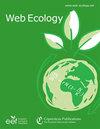Plant clustering generates negative plant–soil feedback without changing the spatial distribution of soil fauna
IF 2.4
3区 环境科学与生态学
Q2 ECOLOGY
引用次数: 0
Abstract
Abstract. The spatial distribution of resources affects ecological processes at all levels of biological organization. However, it remains to be tested how the spatial configuration of belowground resources affects the community dynamics of soil organisms and resulting plant–soil feedbacks. We used Agrostis stolonifera plants in different spatial configurations in mesocosms to study the dispersal patterns of soil nematodes and rotifers. Plant–soil feedbacks were later assessed by re-sowing the mesocosms with Lolium perenne and Plantago lanceolata after removing all the initial A. stolonifera plants from the mesocosms. Bacterial-feeding nematodes and rotifers spread fast, whereas plant-feeding nematodes barely dispersed from the release sites. These spread patterns of nematodes and rotifers depended on the life-history traits and not on the spatial pattern of the plants. However, more clustered plants developed a higher total biomass and caused a reduced growth of the subsequent vegetation. Our results demonstrate that the mere spatial pattern of a single plant species can alter the strength of plant–soil feedbacks. This has important implications for understanding the impact of planting or replanting schemes and other changes in the spatial configuration of plants on long-term vegetation development and succession.植物聚类在不改变土壤动物空间分布的情况下产生负的植物-土壤反馈
摘要资源的空间分布影响着各级生物组织的生态过程。然而,地下资源的空间配置如何影响土壤生物的群落动态以及由此产生的植物-土壤反馈还有待研究。以不同空间构型的匍匐茎(Agrostis stolonifera)植物为研究对象,研究了土壤线虫和轮虫的扩散规律。在去除所有最初的匍匐茎植株后,通过重新播种二年生黑麦草和车前草来评估植物-土壤反馈。以细菌为食的雄虫线虫传播速度很快,而以植物为食的线虫几乎没有从释放点扩散出去。线虫和轮虫的传播模式与植物的生活史特征有关,而与植物的空间格局无关。然而,越密集的植物总生物量越高,导致后续植被的生长减少。我们的研究结果表明,单一植物物种的空间格局可以改变植物-土壤反馈的强度。这对于理解种植或再种植方案以及植物空间结构的其他变化对长期植被发育和演替的影响具有重要意义。
本文章由计算机程序翻译,如有差异,请以英文原文为准。
求助全文
约1分钟内获得全文
求助全文
来源期刊

Web Ecology
Agricultural and Biological Sciences-Ecology, Evolution, Behavior and Systematics
CiteScore
4.60
自引率
0.00%
发文量
6
审稿时长
17 weeks
期刊介绍:
Web Ecology (WE) is an open-access journal issued by the European Ecological Federation (EEF) representing the ecological societies within Europe and associated members. Its special value is to serve as a publication forum for national ecological societies that do not maintain their own society journal. Web Ecology publishes papers from all fields of ecology without any geographic restriction. It is a forum to communicate results of experimental, theoretical, and descriptive studies of general interest to an international audience. Original contributions, short communications, and reviews on ecological research on all kinds of organisms and ecosystems are welcome as well as papers that express emerging ideas and concepts with a sound scientific background.
 求助内容:
求助内容: 应助结果提醒方式:
应助结果提醒方式:


